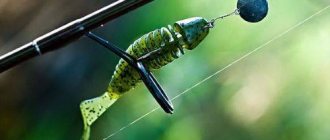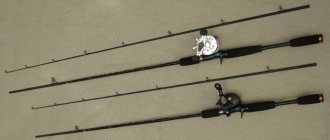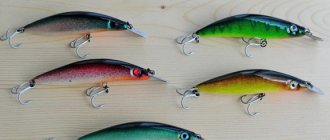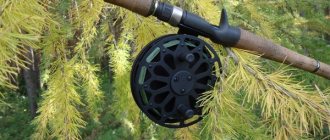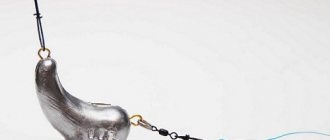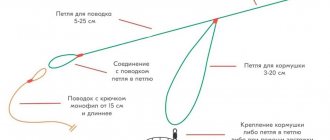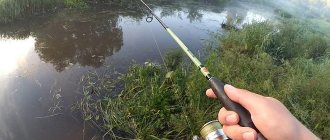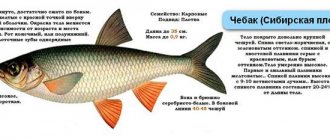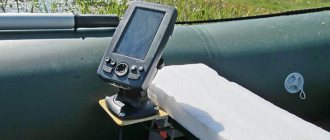What is a jig head
A jig head
is essentially a lead weight of a certain shape with a hook attached to it, designed for catching predatory fish, most often with soft silicone jig baits.
Such baits imitate the color, shape and even the smell of the predator’s favorite prey and can be in the form of fry, worms, crustaceans, etc. They are chosen depending on the various conditions of the reservoir, the fish for which they are intended and other factors. The weight of the bait remains unchanged, but by selecting the weight of the jig head
you can achieve the result you need; fortunately, there is a long weight range for this.
Knowing the expected fishing conditions, an experienced spinning rodist will predict the weight of the head in advance, or adjust it right on the pond, after a couple of test casts. If you are not one and are just thinking about buying a jig head
, then you need to know a few important points about this procedure.
Jig heads review
In the case of a weak current, it is necessary to add another 2-3 g to the indicated weight indicators, with an average one – another 4-6 g, and in case of a strong current, it must be multiplied by 2.
Note that these ratios are not at all strict; every jig fishing fan should experiment with the weight of the weight heads, try different options in practice, paying attention to the reaction and activity of the fish, the degree of sensitivity of the gear, and the efficiency of the retrieve.
In this case, an individual compromise is needed, in which the load would not sink quickly, but not too slowly, and the tackle would feel good.
Another factor that influences the choice of load weight in current conditions is the thickness of the cord.
The thicker the cord, the stronger the force of the current and wind acts on it, that is, the thicker the cord, the greater the weight of the jig head should be.
What should be the weight of the jig head?
Fishing jig heads
may have different shapes, with hooks of different sizes and shank lengths, painted or not, but today we will
only consider the selection of the weight of the head, as one of the most important factors in successful fishing. The wrong choice can ruin all the fisherman's efforts. The weight of the jig head
affects the casting distance, the required depth of wiring and the quality of wiring (its sensitivity and the ability to control it). It is generally accepted that the weight of the jig load should be as low as possible, which will allow the bait to slowly sink to the bottom during a pause. This behavior is the most natural and attractive for the fish, and there is less risk of getting caught. In addition, it is easier for the angler to feel the moment the bait touches the bottom in order to be able to move it along it by dragging or small jumps.
If the load is excessive, you will have to move the bait very quickly to tear it off the bottom, and too little weight will lead to the fact that it will sink for too long and will be strongly carried away by the current on the river. The greater the depth, the heavier the jig head
. It is difficult to give specific numbers, because... their value greatly depends on the bait used, the sensitivity of the spinning rod, the thickness of the fishing line or cord, the presence of a current, and the nature of the bottom. For small baits for small fish in fishing conditions at depths of up to 2 m, weights of 1-4 grams are used, from 2 to 15 m the most commonly used 5 - 20 gram heads are used. Heavier ones will be needed on large rivers with significant depths and powerful currents, where a longer cast is needed. In the presence of a current, the weight of the head changes in one direction or another, depending on the direction of the wiring: against the flow it increases, along the flow it decreases. The main requirement is control of the gear and a clear sense of the behavior of the bait.
Jig head: how to choose the right weight of jig bait
A jig head is essentially a lead weight of a certain shape with a hook attached to it, designed for catching predatory fish, most often with soft silicone jig baits.
Such baits imitate the color, shape and even the smell of the predator’s favorite prey and can be in the form of fry, worms, crustaceans, etc. They are chosen depending on the various conditions of the reservoir, the fish for which they are intended and other factors.
The weight of the bait remains unchanged, but by selecting the weight of the jig head you can achieve the result you need; fortunately, there is a long weight range for this.
Knowing the expected fishing conditions, an experienced spinning rodist will predict the weight of the head in advance, or adjust it right on the pond, after a couple of test casts.
If you are not one and are just thinking about buying a jig head, then you need to know a few important points about this procedure.
What should be the weight of the jig head? Fishing jig heads can have different shapes, with hooks of different sizes and shank lengths, painted or not, but today we will consider the Gamakatsu Mini Jig Head only the selection of the weight of the head, as one of the most important factors of successful fishing.
The wrong choice can ruin all the fisherman's efforts. The weight of the jig head affects the casting distance, the required depth of wiring and the quality of wiring (its sensitivity and the ability to control it).
It is generally accepted that the weight of the jig load should be as small as possible, which will allow the bait to slowly sink to the bottom during a pause.
This behavior is the most natural and attractive for the fish, and there is less risk of getting caught. In addition, it is easier for the angler to feel the moment the bait touches the bottom in order to be able to move it along it by dragging or small jumps.
See also: What to buy first: Winter echo sounder or underwater camera? All the pros and cons, we spend our money wisely.
If the load is excessive, you will have to move the bait very quickly to tear it off the bottom, and too little weight will lead to the fact that it will sink for too long and will be strongly carried away by the current on the river. The greater the depth, the heavier the jig head should be.
It is difficult to give specific numbers, because... their value greatly depends on the bait used, the sensitivity of the spinning rod, the thickness of the fishing line or cord, the presence of a current, and the nature of the bottom. For small baits for small fish in fishing conditions at depths of up to 2 m, weights of 1-4 grams are used, from 2 to 15 m the most commonly used 5 - 20 gram heads are used.
Heavier ones will be needed on large rivers with significant depths and powerful currents, where a longer cast is needed. In the presence of a current, the weight of the head changes in one direction or another, depending on the direction of the wiring: against the flow it increases, along the flow it decreases. The main requirement is control of the gear and a clear sense of the behavior of the bait.
The nuances of choosing the right jig head Microjig Gamakatsu 1g Experts say that a sharp rise of the bait from the bottom attracts the attention of the fish, and during a slow fall an attack follows.
But different types of fish have their own habits - pike often bites on long pauses (15-20 seconds), and pike perch on short pauses (5 seconds). Keep this in mind when selecting your load so that the right jig head best offers the bait to the prey you want.
See also: Marketing versus real reviews. Who to believe?
If the bait sinks faster than 5 seconds, it is better to replace the head with a lighter one, because too short pauses and rapid movements during the retrieve are more likely to scare away the fish than to provoke a bite.
There are also more subtle nuances in choosing a jig head that contradict all of the above. They refer to the case when the weight of the jig is deliberately overestimated or underestimated.
They are overestimated when you need to cast as far as possible and there is no other way to solve the problem.
Another case is when the fish stubbornly does not want to leave the bottom, but you want to attract its attention. Or you use a specific edible, for example, in the form of a crustacean, which, let’s say, is not a particularly swimming creature.
In both cases, the bait will knock loudly when falling to the bottom and raise a cloudy cloud that will attract the attention of a capricious predator. At first glance, everything looks quite complicated, but in practice it is learned much faster, so don’t be lazy.
Make a jig head yourself or buy a ready-made one? You can make a jig head yourself, but if you don’t have the proper experience, it’s better to trust the professionals.
Today, fishing stores offer a wide variety of jig heads from a variety of manufacturers, among which Decoy jig heads from the Japanese company Katsuichi, owner of the Decoy brand, known as a manufacturer of high-end fishing hooks, will never get lost.
Its jig heads have different shapes, are equipped with branded very durable regular and offset hooks, systems for protecting the hook from snagging and fixing soft bait. The unsurpassed Japanese workmanship is evident even in the quality of the weight casting.
Source
The nuances of choosing the right jig head
Experts say that a sharp rise of the bait from the bottom attracts the attention of the fish, and during a slow fall an attack follows. But different types of fish have their own habits - pike often bites on long pauses (15-20 seconds), and pike perch on short pauses (5 seconds). Keep this in mind when selecting your load so that the right jig head
best offers the bait to the prey you want.
If the bait sinks faster than 5 seconds, it is better to replace the head with a lighter one, because too short pauses and rapid movements during the retrieve are more likely to scare away the fish than to provoke a bite. There are also more subtle nuances in choosing a jig head that contradict all of the above. They refer to the case when the weight of the jig is deliberately overestimated or underestimated. They are overestimated when you need to cast as far as possible and there is no other way to solve the problem. Another case is when the fish stubbornly does not want to leave the bottom, but you want to attract its attention. Or you use a specific edible, for example, in the form of a crustacean, which, let’s say, is not a particularly swimming creature. In both cases, the bait will knock loudly when falling to the bottom and raise a cloudy cloud that will attract the attention of a capricious predator. At first glance, everything looks quite complicated, but in practice it is learned much faster, so don’t be lazy.
Make a jig head yourself or buy a ready-made one?
You can make a jig head yourself, but if you don’t have the proper experience, it’s better to trust the professionals. Today, fishing stores offer a wide variety of jig heads from various manufacturers, among which Decoy jig heads
from the Japanese company Katsuichi, owner of the Decoy brand, known as a manufacturer of high-end fishing hooks. Its jig heads have different shapes, are equipped with branded very durable regular and offset hooks, systems for protecting the hook from snagging and fixing soft bait. The unsurpassed Japanese workmanship is evident even in the quality of the weight casting.
Our store experts will help you make a choice and buy the best jig heads in Ukraine
.
In addition to them, you can choose an inertia-free spinning reel
, high-quality silicone jig baits,
wobblers for pike
and any other products needed in a spinning player’s arsenal.
Stationary jig heads
Stationary jig heads require a rigid connection between the hook and the load. Such jigs were the very first to appear, and for a long time were considered “classics of the genre.” But even now, with the advent of hinges, stationary jig heads have not disappeared from jig boxes. And that's why. Thanks to the rigid connection, the hook threaded into the body of the silicone bait is almost always positioned with the tip up.
But this is the position of the hook that is most successful for the most effective hooking. And during wiring, the so-called “sticking” of the hook in the weight ring will never occur, during which the effectiveness of the animation will sharply decrease. On stationary installations, the game turns out to be more measured, smooth and without glitches. Very often this is exactly what a predator needs.
There are also a number of baits, the best qualities of which are revealed only on stationary jigs. You can never read this on the packaging, but even with a little experience you can understand which bait is best to put on which rig. However, this is far from the most decisive factor, and it is better for a beginner not to start with this. Understanding such subtleties will come with experience.
Stationary jig heads, other things being equal, are also good to use in situations where a predator attacks baits “in the air” without really studying them before throwing. This “study” is typical mainly for perch and pike perch. They sometimes only decide to attack when the jig lies on the bottom and the bait falls after it. Here the stationary installation will already lose to the hinged one.
Indeed, in this case, the fish will have to pick up the bait along with the load, and this always causes great distrust and suspicion. There is not a single living object in reservoirs that has the density of lead, much less tungsten. The pike is another matter. Almost all of its attacks occur while the bait is hovering in the water column (mainly near the bottom) and the mass of the jig will not have a strong effect here. This means that a classic jig head is perfect.
Naturally, stationary jig heads have other disadvantages. Firstly, due to the high drag of the rigid connection, the casting range is noticeably reduced. Secondly, for the same reasons, such installations take longer to sink to the bottom (although this is often a plus). Thirdly, we do not have the opportunity to vary the size of baits - we only put the one that fits the hook of a given jig head. Fourthly, in some situations when fishing, a fish can free itself from the hook using a rigid connection as a lever. Most of these shortcomings are eliminated by the second, much younger method of attaching the hook and load - hinged.
Choosing the optimal weight of a jig head or eared sinker
How to choose the right load itself and, most importantly, its weight?
Theoretically, the weight of the sinker should ensure that the bait is pulled at the desired depth at the desired pace with an attractive game. To be specific, it all depends on the conditions.
If we are fishing with a jig, then the sinker should first provide a classic step-by-step retrieve, that is, the bait should fall to the bottom in 2-3 seconds when paused. If a predator is capricious, it is useful to slow down the fall, for which we select a sinker a little lighter than the “norm”. If the fisherman has a zhor, you can speed up the retrieval, for which we select a heavier sinker. Naturally, everything is within reasonable limits.
Another typical option is to catch pike and perch with a light jig along the grass or in rare algae. The depth in such places is small, so we use a relatively light sinker so that the bait moves evenly or in a “pelagic step” somewhere in the water. The bite is good - we make the bait heavier and speed up the retrieve. The bite is bad - lighten the sinker and slow down the retrieve. There is no bite - we select the easiest bait to play, set the minimum sinker, which still ensures play on the fall, and make the slowest retrieve with the maximum vertical component. Here comes the long-awaited bite!
Almost the initial weight of the sinker is selected empirically for each fishing area. It depends on the depth, current speed, wind strength and is usually in the range of 5-30 g. Therefore, by analogy with the classification of fishing rods, sinkers and jig heads can also be divided into light 3-10 g, medium - 10-20 g and heavy ones - 20-40 g. However, sometimes ultra-light weights of 1-3 g, and especially heavy ones over 40 g are used.
Selecting the weight
The weight of the jig head must be selected in such a way as to achieve the desired speed of the bait falling to the bottom. As a rule, with a classic step retrieve, the jig head should fall from 2 to 4 seconds.
For fishing in ponds
For fishing in small standing reservoirs you will need the following weights of weight heads:
| Depth | Weight |
| up to 2 m | 2-6 g |
| 2-4 m | 5-10 g |
| 4-6 m | 8-12 g |
| more than 6 m | 12-18 g |
On large lakes and reservoirs
When fishing on larger bodies of water, slightly heavier jig heads are needed. Below is a table of correspondence between the depth of the reservoir and the weight of the heads:
| Depth | Weight |
| up to 2 m | 4-8 g |
| 2-4 m | 6-12 g |
| 4-6 m | 10-14 g |
| 6-10 m | 14-20 g |
| over 10 m | 18-30 g |
On the rivers
For fishing in the current, you will need heavier jig heads than those used in still waters, since the flow of water pushes the bait upward, and the spinner, in order not to lose contact with the bottom, needs to weigh the bait .
The choice of a specific weight depends on the strength of the current and the activity of the fish; in most cases, it is advisable to choose such jig heads so that the time the bait falls on the step is the same 2, 3 or 4 seconds. For most medium and small lowland rivers, when fishing at depths from 2 to 5 meters, weight heads weighing 8-16 g are suitable. The stronger the current, the heavier and more compact sinkers will be needed .
And do not forget that the key to success in fishing is knowledge of theory, supported by practice . After all, a truly clear understanding of which jig head should be used in what conditions comes with experience.
Some subtleties of selecting hooks and jig heads in the video for beginner fishermen.
Source: fishcave.ru
Choosing the optimal shape of jig head or sinker for jig
If we fish with jig heads, the range of which is quite large, choosing the optimal shape of the sinker becomes a difficult task. However, this issue has already been discussed in the article Jig heads for silicone baits, so we will not repeat it.
But there are only two options for eared sinkers - “ball” and “lentil” (a ball flattened from the sides). Which is better?
When fishing with plastic baits, both uniform and stepped retrieves are used. It is believed that when uniform, “lentils” are better, because it flows more smoothly around the water. When a ball weight flows around a ball, a small zone of turbulence is formed behind it, which can affect the play of the bait. This is probably true for rotating spinners with a ball head, where the turbulent wake interferes with the operation of the petal. But with a vibrating tail, the working part is located far behind and is almost not affected by turbulence, except with the largest loads and the smallest “fish”. At least, my practice of uniform wiring did not show a noticeable difference in the bite between ball heads and “lentils”.
But when moving jig baits in stages, the issue of the shape of the sinker is controversial. On the one hand, the ball weight seems to have an advantage over the “lentil”. After all, at the bottom the “lentil” falls on its side, the “fish” too, and the hooks often cling to the bottom. In addition, the consistent play of the bait is disrupted, because with the next pull, the load and the “fish” must “restore” to the working position, which results in the loss of part of the useful path. Therefore, if you decide to settle on one type of weight head, then the “ball” is undoubtedly more versatile.
But on the other hand, we can say that when the “lentil” falls on its side, more bottom turbidity rises and the play of the bait in the horizontal plane is diversified, which in some conditions will be useful. Whether this is true or not depends on the fish and specific conditions, so the question is still open.
Nevertheless, with even wiring, I still recommend “lentils”. There is one little trick here that I have been using for many years. If the front ear of a “lentil” is bent to one side, and the back ear to the other, then such a curved weight will give the entire bait the most natural wave-like action and make it unsurpassed.
Types of jig heads
All jig heads are divided into 2 types:
- combined with a hook;
- without a hook.
The most popular jig head option among fishermen is one cast together with a hook. Presented in the form of a heavy jig with a ring and a rivet for fixation. The ring itself is located towards the fore-end, and the stopper located on it prevents the bait from turning and sliding.
At the moment, clamps can be selected from the following types:
- arrow;
- umbrella (mushroom);
- needle (thorn);
- ball.
Non-hook jig head
In appearance it is practically indistinguishable from standard samples, but has some differences. Its protective properties in the form of a wire fuse are ideal when fishing in reservoirs rich in natural vegetation: thickets of reeds, snags, and so on. However, some heads, due to their shape, practically do not cling to obstacles: for example, similar ones, a boot or a spoon.
The same applies to elongated versions in the shape of a ski or banana, with a reduced likelihood of lateral snagging.
The operation of the non-hook is quite effective when hunting predators and does not cause any complaints. The only drawback is considered to be the increased number of idle bites.
Difference in shape
“I will choose what is beautiful,” you can sometimes hear a similar phrase. For experienced fishermen, jig heads of the most intricate designs are available to choose from.
Among them are:
- in the form of a ball;
- spoons, boots;
- bananas, horseshoes;
- fish heads;
- oval, ski;
- bullets.
The final choice depends on the angler's individual preferences. If the design influences the process, it is rather indirect. It's better to have several different options together.
Equipment options
To know how to choose the right specimen correctly, you should follow a simple method: it all depends on the type of hook and the type of head.
Namely:
- The pattern combined with the hook allows you to quickly bait soft-bodied baits. It is enough to know how to choose the right silicone fish and jig so that the hook shows slightly outward in the area of the dorsal fin. This will allow you to securely fix the bait without scaring away hungry fish.
- In a situation with a double-type hook, it is better to mark the exit point immediately. It is worth making holes at the designated points, and then, spreading the double, string the bait through the eye of the hook. Well, then push it to the central part in the direction of the head.
- If you have to choose a tee, you also cannot do without preliminary holes. Depending on the size of the silicone bait, the puncture site should be chosen in the gill area.
Depending on the shape of the hook, it is worth placing the bait along it. Otherwise, there is a risk of scaring away an aquatic predator. Or maybe even lose the equipment completely.
Vibration tail tuning
Many fishermen, wanting to improve the catchability of a vibrotail, resort to tuning the bait. Refinement can be carried out in several directions.
- Sometimes it is possible to increase the number of bites by painting. For this purpose, it is useful to carry waterproof markers with you. For example, if you make the back of the rubber black and draw a red dot on each side in the head area, then the predator will attack the bait more often.
- There are several ways to improve tail play. The easiest way is to make longitudinal or transverse cuts at the tail constriction. A similar effect is achieved by drilling through holes in the narrowing. You can thin the narrow part of the tail by stretching it. It is enough to immerse the vibrating tail in boiling water for a couple of seconds to stretch the rubber. After this, you should immediately cool the silicone fish in cold water.
- You can make a symbiosis of the moving body of a twister with the tail part and hoof of a vibrotail. Installation is easy with matches or instant glue.
- Experienced fishermen have noticed that the predator responds better to vibrating tails that have positive or neutral buoyancy. This can be done by introducing polystyrene foam or construction foam into the body. In the case of foam plastic, the volume of the foreign body can be precisely selected. The body is cut, a foam plate is inserted into it, and then the damaged rubber is glued or soldered. Injecting polyurethane foam looks simpler. First, a hole is drilled in the body, and then the gun is inserted and the extruder is inserted at a minimum feed. After a couple of hours it will harden, the excess can be cut off with a knife and the vibrating tail can be tested. Ideally, it is desirable to ensure that the bait hangs in the water column.
Vibrotail is one of the simplest and most affordable artificial baits. If you choose the right tires for the conditions of the reservoir and perform the appropriate wiring, you will have a real chance of catching fish. And if the predator doesn’t like the bait in some way, then it can be modified right while fishing.
Source: fishelovka.com
How to choose a jig head for a vibrotail
